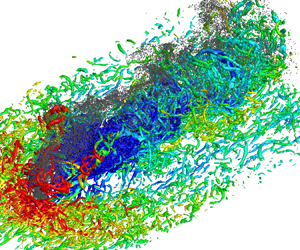Published online by Cambridge University Press: 05 December 2024

In this study, direct numerical simulation of the particle dispersion and turbulence modulation in a sonic transverse jet injected into a supersonic cross-flow with a Mach number of 2 was carried out with the Eulerian–Lagrangian point-particle method. One single-phase case and two particle-laden cases with different particle diameters were simulated. The jet and particle trajectories, the dispersion characteristics of particles, and the modulation effect of particles on the flow were investigated systematically. It was found that large particles primarily accumulate around shear layer structures situated on the windward side of the jet trajectory. In contrast, small particles exhibit radial transport, accessing both upstream and downstream recirculation zones. Moreover, small particles disperse extensively within the boundary layer and large-scale shear layers, evidently influenced by the streamwise vortices. The particles increase the mean wall-normal velocity near the wall in the wake region of the transverse jet, while reducing the mean streamwise and wall-normal velocities in outer regions. Particles significantly alter the flow velocity adjacent to shock fronts. In particular, the turbulent fluctuations near the windward barrel shock and bow shock are reduced, while those around the leeward barrel shock are increased. An upward displacement of the bow shock in the wall-normal direction is also observed due to particles. In the regions away from the shocks, small particles tend to amplify the Reynolds stress, while large particles attenuate the turbulent kinetic energy.